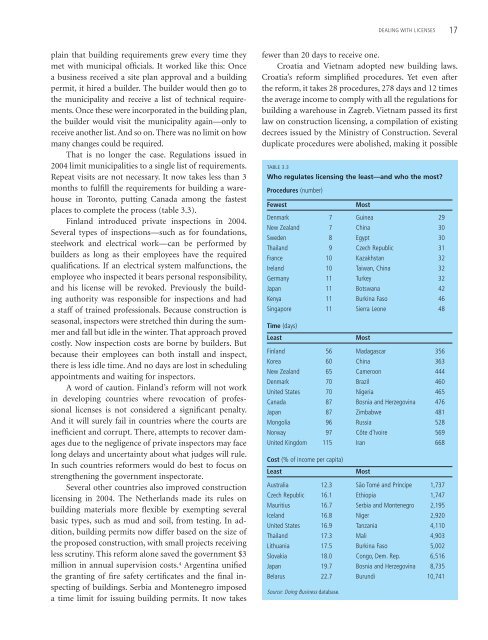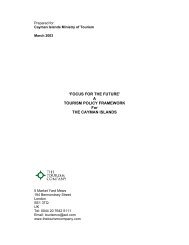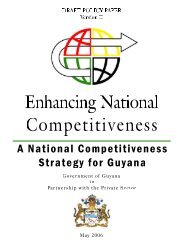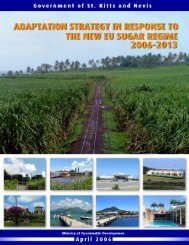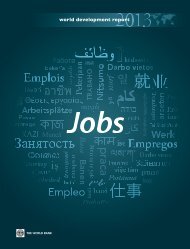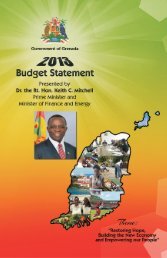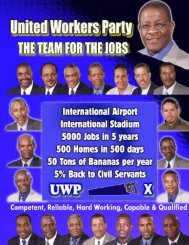Creating
Doing Business in 2006 -- Creating Jobs - Caribbean Elections
Doing Business in 2006 -- Creating Jobs - Caribbean Elections
You also want an ePaper? Increase the reach of your titles
YUMPU automatically turns print PDFs into web optimized ePapers that Google loves.
DEALING WITH LICENSES 17<br />
plain that building requirements grew every time they<br />
met with municipal officials. It worked like this: Once<br />
a business received a site plan approval and a building<br />
permit, it hired a builder. The builder would then go to<br />
the municipality and receive a list of technical requirements.<br />
Once these were incorporated in the building plan,<br />
the builder would visit the municipality again—only to<br />
receive another list. And so on. There was no limit on how<br />
many changes could be required.<br />
That is no longer the case. Regulations issued in<br />
2004 limit municipalities to a single list of requirements.<br />
Repeat visits are not necessary. It now takes less than 3<br />
months to fulfill the requirements for building a warehouse<br />
in Toronto, putting Canada among the fastest<br />
places to complete the process (table 3.3).<br />
Finland introduced private inspections in 2004.<br />
Several types of inspections—such as for foundations,<br />
steelwork and electrical work—can be performed by<br />
builders as long as their employees have the required<br />
qualifications. If an electrical system malfunctions, the<br />
employee who inspected it bears personal responsibility,<br />
and his license will be revoked. Previously the building<br />
authority was responsible for inspections and had<br />
a staff of trained professionals. Because construction is<br />
seasonal, inspectors were stretched thin during the summer<br />
and fall but idle in the winter. That approach proved<br />
costly. Now inspection costs are borne by builders. But<br />
because their employees can both install and inspect,<br />
there is less idle time. And no days are lost in scheduling<br />
appointments and waiting for inspectors.<br />
A word of caution. Finland’s reform will not work<br />
in developing countries where revocation of professional<br />
licenses is not considered a significant penalty.<br />
And it will surely fail in countries where the courts are<br />
inefficient and corrupt. There, attempts to recover damages<br />
due to the negligence of private inspectors may face<br />
long delays and uncertainty about what judges will rule.<br />
In such countries reformers would do best to focus on<br />
strengthening the government inspectorate.<br />
Several other countries also improved construction<br />
licensing in 2004. The Netherlands made its rules on<br />
building materials more flexible by exempting several<br />
basic types, such as mud and soil, from testing. In addition,<br />
building permits now differ based on the size of<br />
the proposed construction, with small projects receiving<br />
less scrutiny. This reform alone saved the government $3<br />
million in annual supervision costs. 4 Argentina unified<br />
the granting of fire safety certificates and the final inspecting<br />
of buildings. Serbia and Montenegro imposed<br />
a time limit for issuing building permits. It now takes<br />
fewer than 20 days to receive one.<br />
Croatia and Vietnam adopted new building laws.<br />
Croatia’s reform simplified procedures. Yet even after<br />
the reform, it takes 28 procedures, 278 days and 12 times<br />
the average income to comply with all the regulations for<br />
building a warehouse in Zagreb. Vietnam passed its first<br />
law on construction licensing, a compilation of existing<br />
decrees issued by the Ministry of Construction. Several<br />
duplicate procedures were abolished, making it possible<br />
TABLE 3.3<br />
Who regulates licensing the least—and who the most?<br />
Procedures (number)<br />
Fewest<br />
Most<br />
Denmark 7 Guinea 29<br />
New Zealand 7 China 30<br />
Sweden 8 Egypt 30<br />
Thailand 9 Czech Republic 31<br />
France 10 Kazakhstan 32<br />
Ireland 10 Taiwan, China 32<br />
Germany 11 Turkey 32<br />
Japan 11 Botswana 42<br />
Kenya 11 Burkina Faso 46<br />
Singapore 11 Sierra Leone 48<br />
Time (days)<br />
Least<br />
Most<br />
Finland 56 Madagascar 356<br />
Korea 60 China 363<br />
New Zealand 65 Cameroon 444<br />
Denmark 70 Brazil 460<br />
United States 70 Nigeria 465<br />
Canada 87 Bosnia and Herzegovina 476<br />
Japan 87 Zimbabwe 481<br />
Mongolia 96 Russia 528<br />
Norway 97 Côte d’Ivoire 569<br />
United Kingdom 115 Iran 668<br />
Cost (% of income per capita)<br />
Least<br />
Most<br />
Australia 12.3 São Tomé and Príncipe 1,737<br />
Czech Republic 16.1 Ethiopia 1,747<br />
Mauritius 16.7 Serbia and Montenegro 2,195<br />
Iceland 16.8 Niger 2,920<br />
United States 16.9 Tanzania 4,110<br />
Thailand 17.3 Mali 4,903<br />
Lithuania 17.5 Burkina Faso 5,002<br />
Slovakia 18.0 Congo, Dem. Rep. 6,516<br />
Japan 19.7 Bosnia and Herzegovina 8,735<br />
Belarus 22.7 Burundi 10,741<br />
Source: Doing Business database.


